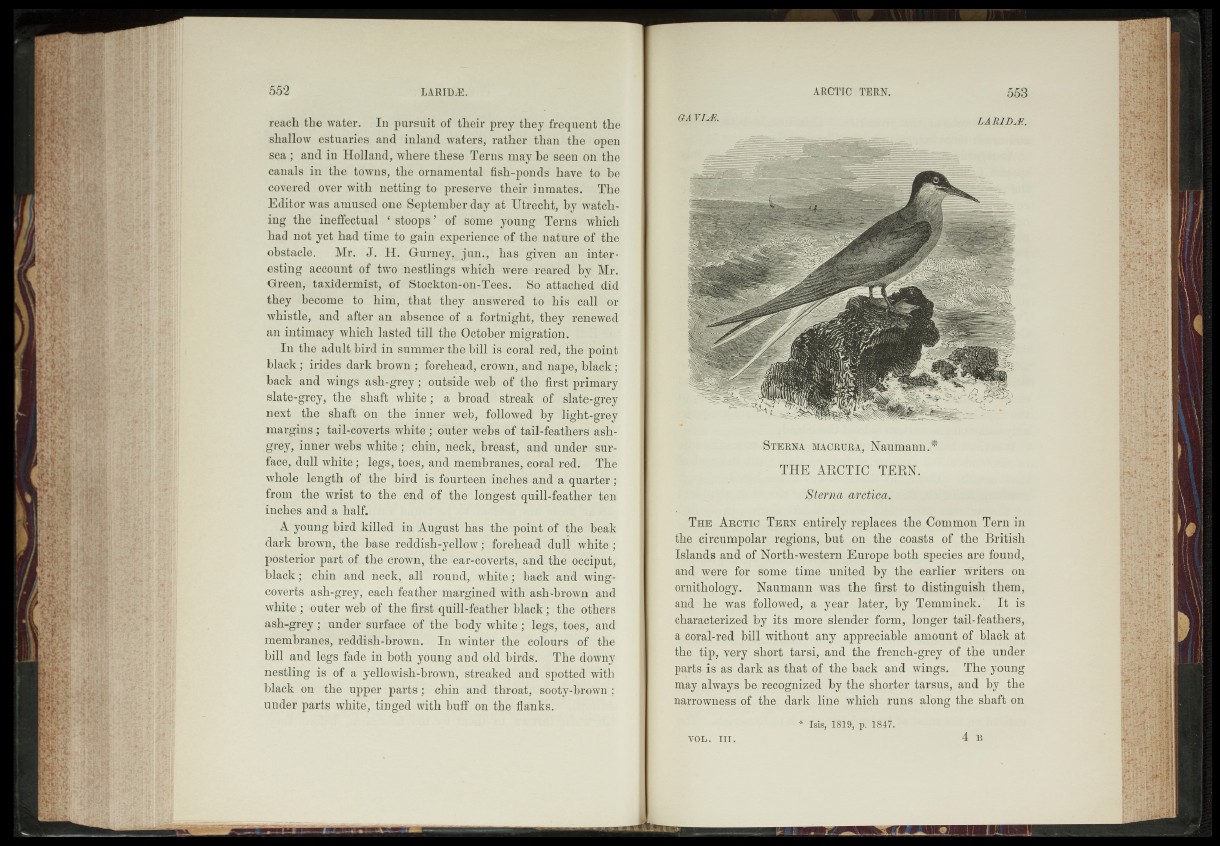
reach the water. In pursuit of their prey they frequent the
shallow estuaries and inland waters, rather than the open
sea ; and in Holland, where these Terns may betseen on the
canals in the towns, the ornamental fish-ponds have to he
covered over with netting to preserve their inmates. The
Editor was amused one September day at Utrecht, by watching
the ineffectual i ■ stoops ’ ■ of some young Terns which
had not5 yet had time to gain- experienoeoofthe nature of the
obstacle. Mr. J. H. Gurney^jun., has given an interesting
account of two nestlings which were .-reared by. M r .
Green, taxidermist, of* Siocktoh-on-iTees.C So attached did
they become'to him,, that they answered to his*.call or
whistle, and after an absences of' a fortnight, they renewed
an intimacy which lasted till the.October migration.
In the adult bird in summer the bill is,coral red, the point
black; irides dark brown; forehead, crown, and nape, black;
back and wings ash-grey; Outside web of ‘the first primary
slate-grey, the shaft white; a broad? streak off slate-grey
next the shaft on the inner web, followed by Bight-§Key
margins; tail-coverts white ; Outer webs of tail-feathers ash-
grey, inner- webs white flcMiSV neck,' breast, and under surface,
dull white.; legs, toes, and membranes, coral red.>The
whole length i of "the ’ bird is fourteen inches :and a quarter;
from the wrist to'-the end of ihS~ longest quill-feather ten
inehes and a half.
A young bird killed in August has the- point of the beak
dark .Mown, the base reddish-yellow ;• -forehead dull white-.;
posterior part of „the crown, the ear- coverts, and' th<i Occiput,
black; chin and nedk, all Mound, white; back and wing-
cóvèrts ash-grèy, each featherunargined pith* ashWbroiwn and
white; -outer web ofttha.first;quill-feather black; Ihe otkers
ash-grey; under surface of the" body white.; legs,fifoe^ and
membranes, reddish-brown. Win winter tlaè'.^ol'&U'réVnf'* the
bill andlëgs fade in both young and old birds. ?^TËè downy
nestling&SI of a yeliowlsh:brown, streaked and. spotted* with
black Ion thé upper parts; chin and .throat,-'sooty-brown ;
under parts white,ftinged With buff on the flanks.
Sterna macrura, Naumann.*
H f e f t ARCTIC TERN.
Sterna arctica. ■
The Arctic Tern entirely replaces the Common Tern in
t^e-..circumpolar-, regions, but jm the coasjts ^ the British
Islands and of North-western Europe both species are found,
and were for some time united by the earlier .writers op-
"ornithology. . Naumann was the first to distinguish them,
and-he was followed,, a yep,r later, by,, Temminek. ^.It.^is
”^^r||cterized; by,its .more slender form,, longer tail-feather^
a, coral-red bill wlthout,i;any , appreciable - amount of black at
%e tip, very .short harei. and thea.fenrch^grey of the under
parts is as dark as thatjOf the back and wi.ngg?, The young
may always be recognized by the shorter tarsus, and by, the,
narrowness of the dark, line which rqns along thje ,shaft ob,
* p*?' 18”47.
von. i ii; I 4 b